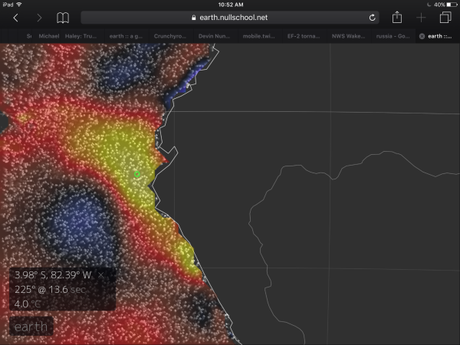GR: More from Robert Scribbler on the intense storms of global warming.
As the lower atmosphere becomes warmer, evaporation rates will increase, resulting in an increase in the amount of moisture circulating throughout the troposphere (lower atmosphere). An observed consequence of higher water vapor concentrations is the increased frequency of intense precipitation events… — NASA’s Earth Observatory
“Just off the coasts of Colombia, Ecuador and Peru, the Pacific Ocean has been abnormally warm of-late. For the past month, sea surface temperatures have ranged between 3 and 5 degrees Celsius above average. This excess heating of the ocean surface, facilitated by human-forced climate change, has pumped a prodigious volume of moisture into the atmosphere of this coastal region. Southerly winds running along the western edge of South America have drawn this moisture north and eastward — feeding into the prevailing storms that originate on the Atlantic side of South America and track eastwards.

Sea surface temperature anomaly map from Earth Nullschool shows 4 degree Celsius above average ocean surfaces just off-shore of Ecuadore and Colombia. These extremely warm waters have helped to fuel very severe storms over Peru and Colombia during recent weeks. Such warm ocean waters are not normal and their highest peak temperatures are being increased by a human-forced warming of the Earth, primarily through fossil fuel burning. Image source: Earth Nullschool.
“Lately, these systems have blown up to enormous size as they’ve run across the Andes or collided with pop-up storms along the coast. And the amount of rainfall coming out of the resulting monster thunderstorms has been devastating. In Peru, hundreds of thousands of people have been rendered homeless by these deluges which have caused the tragic loss of 100 souls, destroyed thousands of buildings, 200 bridges, and 2,000 miles of highway. For the state, the estimated damage toll from this ongoing climate disaster is now 6 billion dollars.
“Friday night, a member of this new breed of monster thunderstorms, pumped to greater intensity by the moisture bleed off the record warm ocean waters, unloaded a total of a half-month’s worth of rainfall in just a few hours upon the small Colombian city of Mocoa. More than five inches fell in 1-2 hours on a region where three rivers run out of the mountains toward this community of 40,000. The deluge arrived in the darkness. Its ferocious intensity unleashed a massive flood of boulders, mud, and water as the combined rivers leapt their banks and invaded the town. A nearby hillside, unable to retain integrity beneath this merciless assault of the elements, gave way — burying a large section of Macoa in rubble.” –Robert Scribbler (Continue: For Colombia, The Rain Bombs of Climate Change Fell in the Dark of Night | robertscribbler.)

